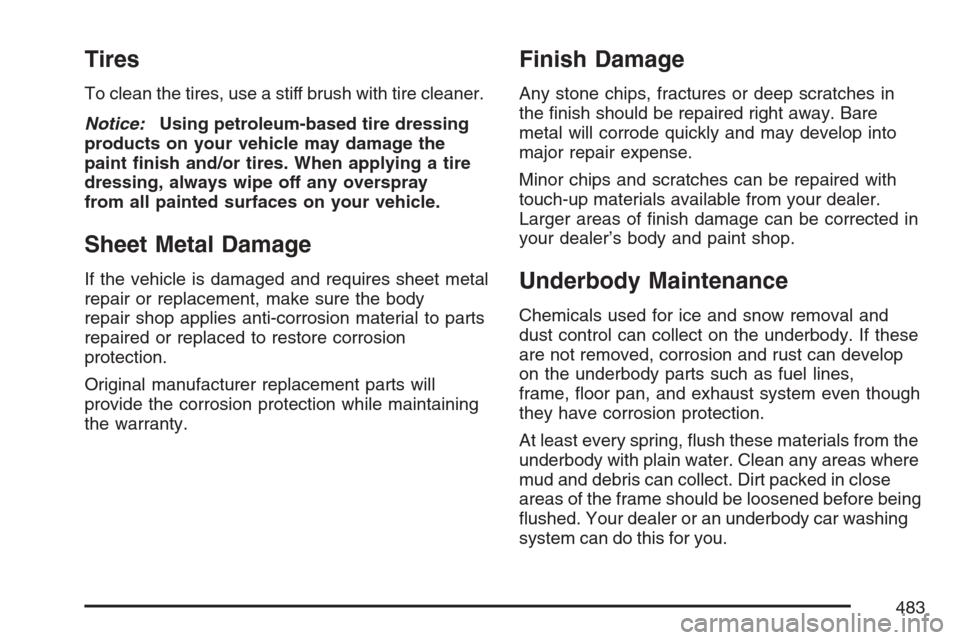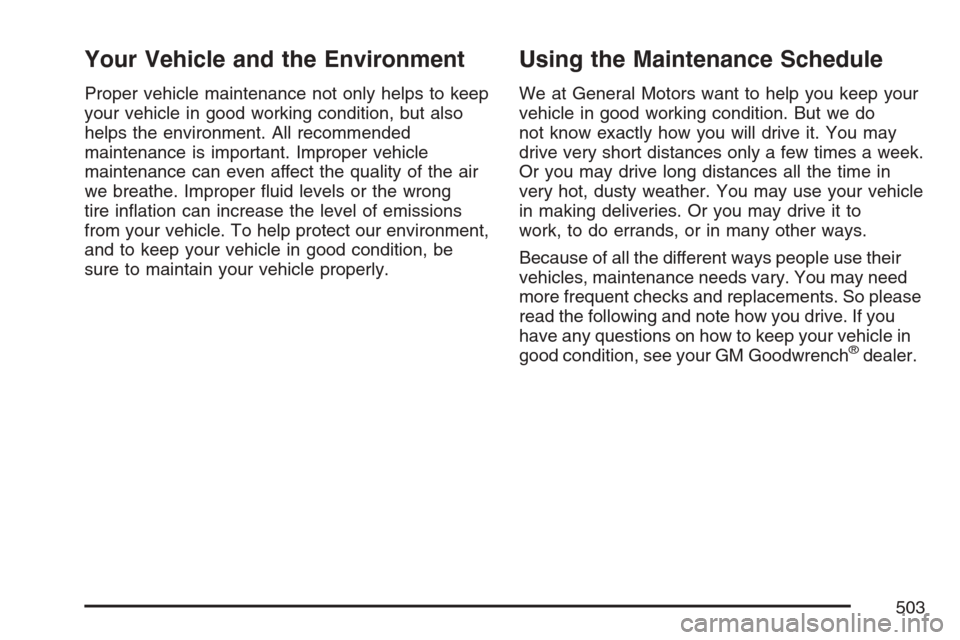Page 435 of 560

Your vehicle has also been equipped with a TPMS
malfunction indicator to indicate when the
system is not operating properly. The TPMS
malfunction indicator is combined with the low tire
pressure telltale. When the system detects a
malfunction, the telltale will �ash for approximately
one minute and then remain continuously
illuminated. This sequence will continue upon
subsequent vehicle start-ups as long as the
malfunction exists.
When the malfunction indicator is illuminated, the
system may not be able to detect or signal low
tire pressure as intended. TPMS malfunctions may
occur for a variety of reasons, including the
installation of replacement or alternate tires or
wheels on the vehicle that prevent the TPMS from
functioning properly. Always check the TPMS
malfunction telltale after replacing one or more
tires or wheels on your vehicle to ensure that the
replacement or alternate tires and wheels allow
the TPMS to continue to function properly.Please note that the TPMS is not a substitute for
proper tire maintenance, and it is the driver’s
responsibility to maintain correct tire pressure,
even if under-in�ation has not reached the level to
trigger illumination of the TPMS low tire pressure
telltale.
A Tire and Loading Information label, attached to
your vehicle, shows the size of your vehicle’s
original equipment tires and the correct in�ation
pressure for your vehicle’s tires when they
are cold. SeeLoading Your Vehicle on page 349
for an example of the Tire and Loading
Information label and its location on your vehicle.
Also seeIn�ation - Tire Pressure on page 431.
Your vehicle’s TPMS can warn you about a low tire
pressure condition but it does not replace normal
tire maintenance. SeeTire Inspection and
Rotation on page 438andTires on page 421.
Notice:Your vehicle has a Tire Pressure
Monitor System (TPMS). Use only the
GM-provided tire sealant. Other liquid tire
sealants may damage the tire pressure
sensors.
435
Page 438 of 560

This device complies with RSS-210 of Industry
Canada. Operation is subject to the following
two conditions:
1. This device may not cause interference.
2. This device must accept any interference
received, including interference that may
cause undesired operation of the device.
Changes or modi�cations to this system by other
than an authorized service facility could void
authorization to use this equipment.
Tire Inspection and Rotation
Tire rotation is not recommended if your vehicle
has the following performance tire combinations:
P235/50R17 size tires on the front wheels
and P255/45R17 size tires on the rear
wheels.
P235/50R18 size tires on the front wheels and
P255/45R18 size tires on the rear wheels.
P255/45R18 size tires on the front wheels and
P275/40R19 size tires on the rear wheels.Different tire sizes should not be rotated front to
rear. Each tire and wheel should only be used
in the original front or rear position it is in.
Tire rotation is recommended if your vehicle is
equipped with P235/50R17 size tires on all
four wheel positions or 255/45ZR18 size tires on
all four wheel positions. These tires should be
rotated every 5,000 to 8,000 miles (8 000 to
13 000 km)
Any time you notice unusual wear, rotate your
tires as soon as possible and check wheel
alignment. Also check for damaged tires or wheels.
SeeWhen It Is Time for New Tires on page 440
andWheel Replacement on page 445for
more information.
The purpose of regular rotation is to achieve more
uniform wear for all tires on the vehicle. The
�rst rotation is the most important. SeeScheduled
Maintenance on page 505.
438
Page 451 of 560

If a Tire Goes Flat
It is unusual for a tire to blowout while you are
driving, especially if you maintain your tires
properly. SeeTires on page 421. If air goes out of
a tire, It is much more likely to leak out slowly.
But if you should ever have a blowout, here are a
few tips about what to expect and what to do:
If a front tire fails, the �at tire will create a drag that
pulls the vehicle toward that side. Take your
foot off the accelerator pedal and grip the steering
wheel �rmly. Steer to maintain lane position,
and then gently brake to a stop well out of the
traffic lane.
A rear blowout, particularly on a curve, acts much
like a skid and may require the same correction
you would use in a skid. In any rear blowout,
remove your foot from the accelerator pedal. Get
the vehicle under control by steering the way
you want the vehicle to go. It may be very bumpy
and noisy, but you can still steer. Gently brake
to a stop, well off the road if possible.If a tire goes �at, and your vehicle has a compact
spare tire, seeChanging a Flat Tire on page 464.
This information shows you how to use your
vehicle’s tire changing equipment and how
to change a �at tire safely.
{CAUTION:
Lifting a vehicle and getting under it to do
maintenance or repairs is dangerous
without the appropriate safety equipment
and training. The jack provided with your
vehicle is designed only for changing a
�at tire. If it is used for anything else, you
or others could be badly injured or killed
if the vehicle slips off the jack. Use the
jack provided with your vehicle only for
changing a �at tire.
If your vehicle has 255/45ZR18 size tires, there is
no spare tire, jack, or tire changing equipment.
A tire in�ator kit, included with your vehicle, may
be used to seal small punctures in the tread
area of the tire. SeeTire In�ator Kit on page 452.
451
Page 468 of 560
{CAUTION:
Lifting a vehicle and getting under it to do
maintenance or repairs is dangerous
without the appropriate safety equipment
and training. The jack provided with your
vehicle is designed only for changing a
�at tire. If it is used for anything else, you
or others could be badly injured or killed
if the vehicle slips off the jack. Use the
jack provided with your vehicle only for
changing a �at tire.Notice:If you position the jack under the
rocker molding and attempt to raise the
vehicle, you could break the molding and/or
cause other damage to your vehicle. Always
position the jack so that when the jack head is
raised, it will �t �rmly in the notch located
inboard from the rocker molding.
4. Turn the wheel wrench counterclockwise to
lower the jack lift head until the jack �ts
under the vehicle.
468
Page 483 of 560

Tires
To clean the tires, use a stiff brush with tire cleaner.
Notice:Using petroleum-based tire dressing
products on your vehicle may damage the
paint �nish and/or tires. When applying a tire
dressing, always wipe off any overspray
from all painted surfaces on your vehicle.
Sheet Metal Damage
If the vehicle is damaged and requires sheet metal
repair or replacement, make sure the body
repair shop applies anti-corrosion material to parts
repaired or replaced to restore corrosion
protection.
Original manufacturer replacement parts will
provide the corrosion protection while maintaining
the warranty.
Finish Damage
Any stone chips, fractures or deep scratches in
the �nish should be repaired right away. Bare
metal will corrode quickly and may develop into
major repair expense.
Minor chips and scratches can be repaired with
touch-up materials available from your dealer.
Larger areas of �nish damage can be corrected in
your dealer’s body and paint shop.
Underbody Maintenance
Chemicals used for ice and snow removal and
dust control can collect on the underbody. If these
are not removed, corrosion and rust can develop
on the underbody parts such as fuel lines,
frame, �oor pan, and exhaust system even though
they have corrosion protection.
At least every spring, �ush these materials from the
underbody with plain water. Clean any areas where
mud and debris can collect. Dirt packed in close
areas of the frame should be loosened before being
�ushed. Your dealer or an underbody car washing
system can do this for you.
483
Page 501 of 560
Maintenance Schedule................................ 502
Introduction............................................... 502
Maintenance Requirements........................ 502
Your Vehicle and the Environment............ 503
Using the Maintenance Schedule............... 503
Scheduled Maintenance............................. 505
Additional Required Services..................... 508
Maintenance Footnotes.............................. 510
Owner Checks and Services..................... 512At Each Fuel Fill....................................... 513
At Least Once a Month............................. 513
At Least Once a Year............................... 514
Recommended Fluids and Lubricants........ 516
Normal Maintenance
Replacement Parts ................................. 518
Engine Drive Belt Routing......................... 519
Maintenance Record.................................. 521
Section 6 Maintenance Schedule
501
Page 502 of 560
Maintenance Schedule
Introduction
Important: Keep engine oil at the proper level
and change as recommended.
Have you purchased the GM Protection Plan? The
Plan supplements your new vehicle warranties.
See your Warranty and Owner Assistance booklet
or your dealer for details.
Maintenance Requirements
Notice:Maintenance intervals, checks,
inspections, replacement parts, and
recommended �uids and lubricants as
prescribed in this manual are necessary to
keep your vehicle in good working condition.
Any damage caused by failure to follow
scheduled maintenance might not be covered
by warranty.
502
Page 503 of 560

Your Vehicle and the Environment
Proper vehicle maintenance not only helps to keep
your vehicle in good working condition, but also
helps the environment. All recommended
maintenance is important. Improper vehicle
maintenance can even affect the quality of the air
we breathe. Improper �uid levels or the wrong
tire in�ation can increase the level of emissions
from your vehicle. To help protect our environment,
and to keep your vehicle in good condition, be
sure to maintain your vehicle properly.
Using the Maintenance Schedule
We at General Motors want to help you keep your
vehicle in good working condition. But we do
not know exactly how you will drive it. You may
drive very short distances only a few times a week.
Or you may drive long distances all the time in
very hot, dusty weather. You may use your vehicle
in making deliveries. Or you may drive it to
work, to do errands, or in many other ways.
Because of all the different ways people use their
vehicles, maintenance needs vary. You may need
more frequent checks and replacements. So please
read the following and note how you drive. If you
have any questions on how to keep your vehicle in
good condition, see your GM Goodwrench
®dealer.
503